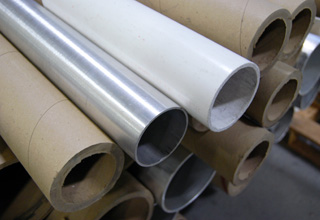by Joe Connelly , Product Manager – Winding and Slitting

A substantial percentage of all products wound into a roll start by applying the material to some form of a tube, or core, to begin the winding process. On the rare occasion, this task can be completed without using a core at all, but the majority use a paper, plastic, or metal tube, with paper being the most commonly used core material. When the roll of material on the core is used up, the core generally gets discarded (think of a roll of paper towels used in your kitchen). These easily disposable items are sometimes viewed as trivial components of the production process, yet they can cause significant pain to those directly involved in the converting process if their quality or physical properties are not suitable for the operation.
Paper cores combine multiple spools of kraft paper, coated with glue, which is then wrapped around a metal mandrel in a spiral pattern to the desired length. The outer diameter of the mandrel sets the inside diameter of the paper tube, and the number of layers of kraft paper determines the core's wall thickness and therefore its outside diameter. Given the kraft paper is created from wood pulp, any variation in temperature and humidity changes the dimensions of the paper tube much like how a drawer in an old table can expand and get stuck during humid summer weather. Longer tubes can become bowed depending on the method used for storage. If these cores are intended to feed automatically from a hopper or roll along a table or support plate, this slight bow can lead to machine jams and can cause the entire upstream process to stop. The grade of paper and adhesive used and how tightly the bundle is wound onto the mandrel can impact the final density of the core. Voids or poorly bonded layers reveal themselves once the cores are cut to length and when the winding operation relies on the core's edges to control its location, these flaws can lead to winding defects or machine stoppages.
For example, when winders for thin-film run at high operating speeds, a tight wind is necessary, and this requires higher nip loading to eliminate entrained air from the package. The result is higher wound-in tension that can generate significant compressive forces at the core. If the core is not structurally capable of supporting this compressive stress, it collapses, or at the very least its inside diameter is reduced, making it difficult or impossible to remove from the winding shaft without physically cutting it off. Yes, the cost of the additional wall thickness increases the cost of each core, but the consequences of not using the proper core can cost much more.
Many forms of slitter rewinders use differential winding shafts that require the cores to rotate or slip over the surface of the shaft. The fit of the core's inside diameter over the body of the shaft must be within the recommended tolerance to ensure proper operation. Excessive clearance can lead to core wobble or tension oscillation and cause winding defects. Not enough clearance can create drag, which imparts higher tension to the wound web. This type of shaft uses locating pins, bearings, or blades to prevent lateral shifting of each core yet allows them to rotate freely. These locating elements can cut, or dig into the cores' edges, allowing sideways shifting and creating excessive dust, sometimes more quickly on some cores than others, depending on their construction. Cores used with this type of differential shaft must have adequate edge rigidity, and proper roundness and straightness to allow smooth rotation over the shaft body without having their edges break down quickly. Cores made of plastic material must meet similar quality standards. Often the type of plastic pipe used for plumbing applications does not meet the roundness and straightness guidelines, nor does it typically have the required inside diameter tolerance to properly fit on a differential winding shaft whose body has been sized for a more popular paper tube inside diameter. Also, core cutters that were intended to process paper cores are not able to cut plastic cores properly. Using a saw or other means to cut the plastic pipe does not always produce an edge that is smooth or square enough to work reliably on a differential shaft.
So be careful in obtaining the right core for the job. It’s tempting to think of them as trivial, consumable components but it is always best to review what's required with the machine or shaft supplier to ensure the core sizes, materials, and physical properties are correct for your operation. Making the wrong choice for such an essential component can cost you more than you might think.